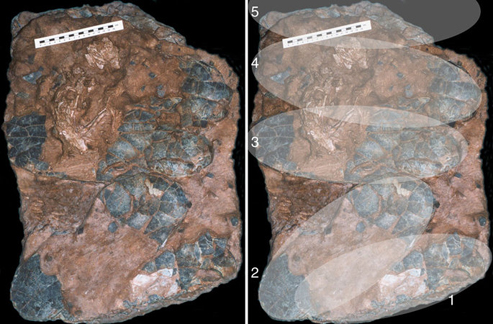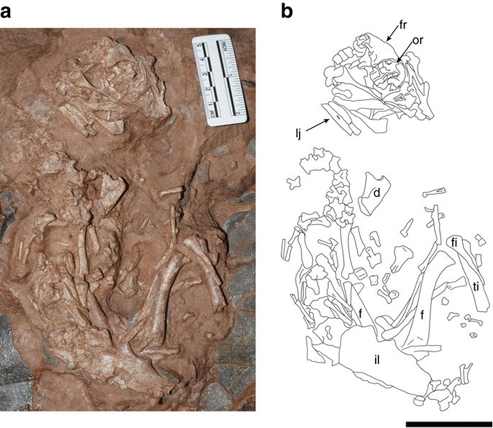A New Species of Giant Oviraptorosaur – Beibeilong sinensis
The mystery of the world’s largest dinosaur eggs has been solved, and an infamous baby dinosaur fossil once the property of the Indianapolis Children’s Museum, now has a family. In 1993, a fossilised clutch of giant dinosaur eggs and an associated embryo dinosaur skeleton was discovered east of the small village of Zhaoying, close to the township of Yangcheng, Xixia County, in western Henan Province. Like many thousands of dinosaur egg fossils found in this part of central China, the specimen was illegally sold overseas to a buyer in America.
A Baby Dinosaur Fossil
The fossil was then sold to the Indianapolis Children’s Museum in 2001. Subsequently, the partial nest with the small, articulated dinosaur skeleton, nick-named “Baby Louie”, was repatriated to China and it is currently housed in the Henan Geological Museum.
In a paper this week in “Nature Communications”, researchers which include Darla Zelenitsky (University of Calgary) and Professor Phil Currie (University of Alberta), have identified a new species of giant Oviraptorosaur – “Baby Louie” represents potentially one of the largest feathered creatures known to science.
The dinosaur has been named Beibeilong sinensis, the name means “baby dragon from China”.
Photographs of the Holotype Fossil Material (Beibeilong sinensis)

Right image shows schematic overlay of approximate locations of individual eggs. Eggs 1 through 4 are in an upper layer just beneath the skeleton, whereas egg 5 is in a lower layer of the block. Scale bar is in centimetres.
Picture credit: Nature Communications/Darla Zelenitsky
The picture above shows two images of the holotype nest fossil from which the new species of dinosaur, B. sinensis was described. The picture on the left shows the fossil material with the embryo fossil located just below the scale bar. On the second photograph, the location of five of the eggs making up the clutch have been superimposed on the fossil to give an indication of their position.
Giant Dinosaur Eggs
The eggs were given their own oogenus, Macroelongatoolithus (the name means “large elongate stone eggs”). These are the largest-known type of dinosaur eggs with some fossils measuring around sixty centimetres in length. The eggs associated with the Beibeilong embryo measure about forty-five centimetres long. That’s about three times as long as a typical Ostrich egg (Struthio camelus), although Ostrich eggs are more ovoid in shape. The research team suggest that the dinosaurs which laid these eggs, giant caenagnathid Oviraptorosaurs, created nests that may have been around three metres in diameter.
An Artist’s Illustration of the Giant Oviraptorosaur Beibeilong sinensis
Picture credit: Zhao Chuang
The Gigantoraptor Effect
The discovery of the giant fragmentary fossils of a strange theropod (Gigantoraptor erlianensis) in 2005 changed views on the Oviraptorosauria clade forever. When formally described in 2007, Gigantoraptor was at least five times bigger than any other known oviraptorid. Palaeontologists had proof that giant, beaked dinosaurs existed.
To read about the discovery of Gigantoraptor: New Giant Member of the Oviraptorosauria – Gigantoraptor.
Beibeilong becomes the second genus of giant members of the Oviraptorosauria. If “Baby Louie” had lived, then this dinosaur might have reached a length of eight metres or more and it would have easily weighed more than a tonne. Beibeilong has been assigned to the Caenagnathidae, an enigmatic group of beaked theropods closely related to the Oviraptoridae and nested with them into the Oviraptorosauria clade.
A Scale Drawing of a Giant Caenagnathid Oviraptorosaur (G. erlianensis)
Picture credit: Everything Dinosaur
Originally, the Caenagnathidae family was erected to describe, what was thought at the time, a lineage of extinct birds. Over the last thirty years or so, more fossil discoveries have been made in North America and Asia. When first described Gigantoraptor was thought to be a member of the Oviraptoridae, however, Gigantoraptor is now joined in the Caenagnathidae by perhaps, the equally large Beibeilong.
An Abundance of Giant Dinosaur Egg Fossils
The Beibeilong material was excavated from strata from the Gaogou Formation (Upper Cretaceous, Cenomanian to Turonian faunal stages). The research team suggest that Beibeilong roamed central China some ninety million years ago, twenty million years earlier than Gigantoraptor.
An abundance of Macroelongatoolithus eggs reported from Asia and North America is in stark contrast to the very few bones found of giant caenagnathids. Thanks to the association between “Baby Louie” and the giant eggs, the first known association between skeletal remains and eggs of caenagnathids, palaeontologists are confident that these giant, beaked dinosaurs may have been relatively common throughout the Northern Hemisphere during the Late Cretaceous.
A View of the Dinosaur Embryo Skeleton (Beibeilong sinensis) and Accompanying Line Drawing
Picture credit: Nature Communications/Darla Zelenitsky
The picture above shows a close view of the embryo skeleton (left) and a simplified line drawing highlighting important bones.
Key
fr = frontal bone (skull), or = orbit (skull), lj = lower jaw, d = dentary, fi = fibula, ti – tibia, il= ilium, f = femur.
Visit the Everything Dinosaur website: Everything Dinosaur.









Leave A Comment